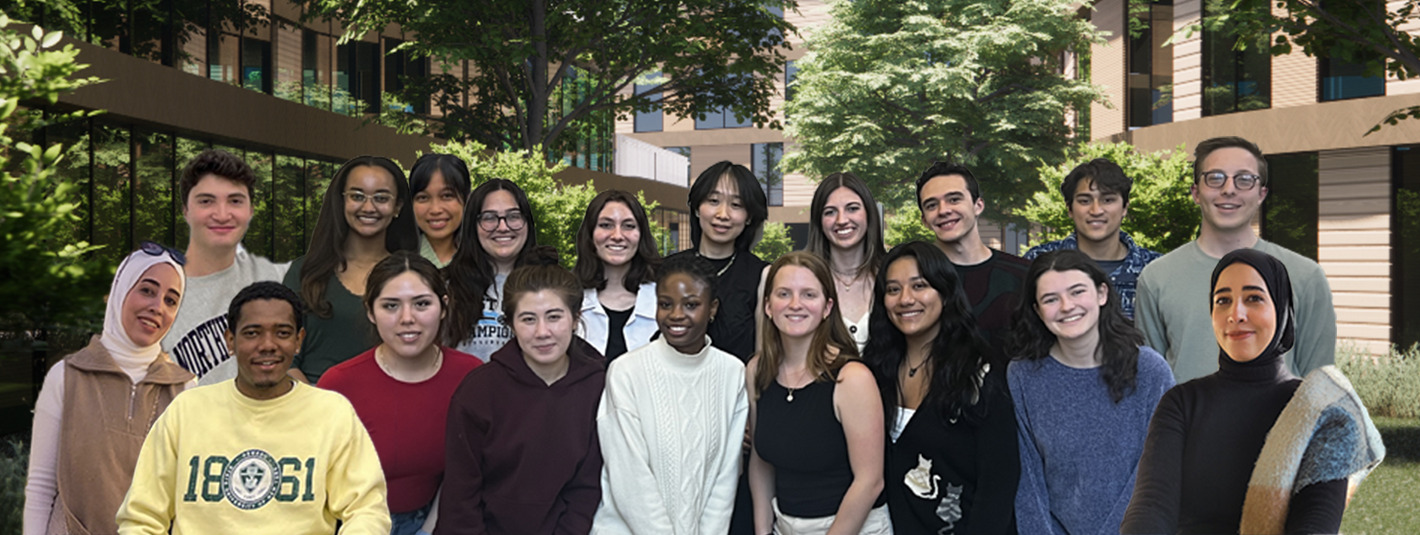Solar Decathlon Team Finalists in DOE Design Competition
Water sustains life, but with its thick black oily sheen, rampart debris, and trash, Ohio’s Cuyahoga River was actively hazardous to Cleveland’s humans and wildlife. But then, something amazing happened: Americans rallied for water pollution control and river clean-up, resulting in a healthier river and several amendments to ensure clean water and protect the environment.
Inspired by Cuyahoga’s transformation from lifeless to life-giving, the students on this year’s solar decathlon team designed a hybrid structure named “RiverBend,” which merited them a trip to the finals at the National Renewable Energy Laboratory in Golden, Colorado where they competed in the “Multifamily Building Division.”
Five team members traveled to the finals, including four CEE students—Hector Ontiveros Morales, Anna Kovacs, Maggie Musgrave, and Maria Monroy Lopez—and Claire Petersen. Team project manager Hector Ontiveros Morales, a junior, organized all 19 team members and delegated tasks.
“This consisted of scheduling meetings within the group and with our project partners at Perkins & Will, compiling the deliverables along with all our presenters, and making renderings throughout,” he said.
Their “RiverBend” design was a multi-family mixed-use building on the Cuyahoga River in Cleveland, OH.
“For RiverBend, we envision a sustainable and affordable community for all residents of Cleveland,” he said. “This means that all of the mixed-use amenities, such as the low-waste grocery store would be available to all community members. The inclusion of affordable housing meets the needs of downtown Cleveland, where there is currently a lack of housing in the core—most people commute from further away thus increasing current transportation costs.”

The structure of “RiverBend” was a timber-concrete hybrid that blended sustainable materials with interesting architecture.
“Additionally, a lot of focus was placed on the MEP (mechanical, engineering, plumbing) systems to make the building function as efficiently as possible,” he said. “The building was net positive, producing more energy than consumed.”
Senior Anna Cao helped conceptualize the overall architectural form of the building. Along with Aya Keskeso and Asmita Dahl from Kent State University, she also developed the site plan and contributed to layouts of the amenity floors.
“Its form was primarily shaped by our site's attributes—the rough L shape aligns with bordering streets while simultaneously mimicking the organic bend of the river (Collision Bend, along the Cuyahoga River in Cleveland),” she said. “Landscaped terraces sweeping down facing the riverfront were intended to provide views and outdoor spaces for residents, with a sizable amenity deck and first-floor retail aiming to provide services for the public. I'd been interested in experimenting with developing the residential floor plans as a double-loaded corridor that doubled back on itself.”
Hector Morales said that the structure’s green roofs were paid special attention.
“There were 7 levels of green roofs,” he said. “The bottom 3 levels would be accessible to everyone and include access to the mixed-use amenities The top 4 levels would be exclusive for the residents which provide plenty of outdoor space, views of the Cuyahoga River, and community gathering spaces in place of private balconies.”
While the team ultimately did not place for an award, they were excited to compete in Colorado.
“We explored the NREL campus, which has many net-zero facilities, so it was great to see some of the designs we proposed for the building implemented in real life,” Morales said. “My favorite part was watching the four grand jury presentations as those teams had an incredible social impact with their projects. We enjoyed seeing innovative retrofit solutions and how international teams approached sustainable infrastructure in their home countries.”
And they’ve already started strategizing for next year.
“We plan to compete again next year, though we intend to split into smaller teams and possibly submit both a multifamily and single-family entry,” he said. “This would make the team work more organized and everyone can work on real-world tasks to enhance skills from their majors or learn new ones!”

